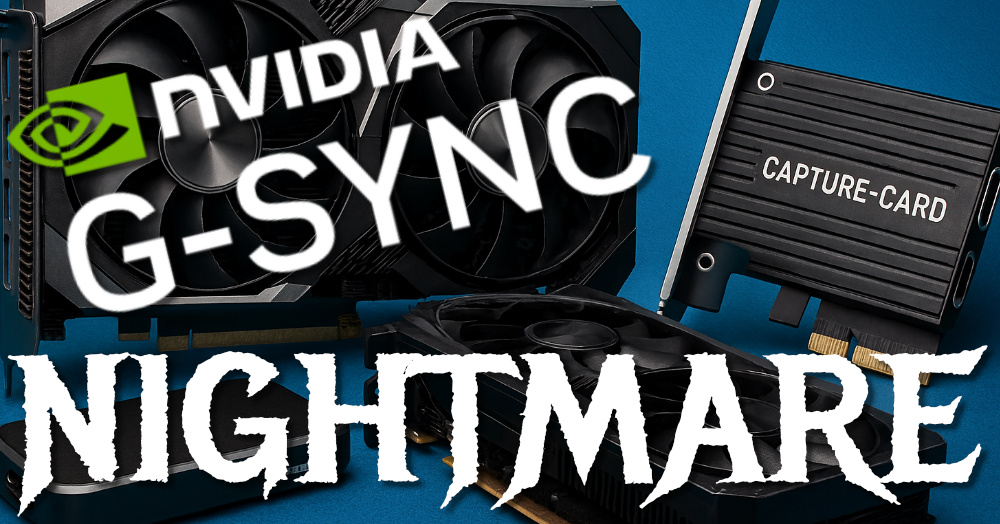Let’s set the scene here. I’m a small content creator that has always used two machines, a gaming rig connected to a streaming rig using a capture card (In this case an Elgato 4K X).
My monitor is an LG UltraGear 32GQ850-B which offers 240hz G-Sync which I’ve decided to try and take advantage of. This post will be updated with my journey as it’s not been a lot of fun so far.
2 main issues are plaguing me. I either get random black screens where the signal either drops out from my monitor, my capture card or both – sometimes coming back, other times just sitting there. The other is random de-syncs on the monitor, looks like a massive frame drop, a screen tear and then recovery (sometimes).
The good news is it feels like I’ve found a solution as I write this, but wondered if the journey might be helpful to someone else out there. The following are copy/paste from Discord posts I made on my Community Discord Server as I tried to resolve the issues.
Please use the comments at the bottom if you want to discuss, I feel like I know WAY MORE than anyone should about Nvidia G-Sync and Capture Cards right now…
28th July 2025
Cannot stress just how much work has gone into troubleshooting these issues. Turns out they are/were two different things and I’ve only been able to confirm this by buying additional kit including a different brand of Capture Card – all of which is going back tomorrow.
So the issues, all from running my video signal from the Gaming PC through the Capture Card at it’s advertised speeds in passthrough mode:
Gaming PC > Capture Card (Connected to Stream PC) > Monitor
Black Flash / Signal Loss
This was incredibly hard to troubleshoot due to it’s very intermittent nature. I eventually found a game that would reliably trigger the issue and it existed on my existing capture card, the splitter and the new capture card. The cause? Combined cable length of 5m (3m + 2m). The fix was finding shorter cable runs and appropriate cables. Combined run is now 4m (2m + 2m) and no more drop outs.
Glitches on Monitor During Gameplay
Hard to replicate initially, but Phasmo is brilliant at doing it now. This is actually a known Gsync error and despite lots of settings you can mess about with both on the Monitor, in Nvidia Control panel and even in the game, it persists. The cause is when there is a quick and significant fps drop, the frame rate changes faster than the monitor can keep up with and messes up frames that then manifest as glitches. Turns out it’s game specific and a combination of:
1) Adjusting in game options to reduce the amount of sudden FPS drops (for example in Phasmo, turning SSO off removes almost all big drops, but weather and video camera night vision and headset night vision can still cause them)
2) Using a specific gaming profile in Nvidia control panel to override the FPS cap (globally set at 226 as per the updated instructions Plat linked the other day). If I set this to 120fps for example, the problem never appears because.
None of the issues exist if I go direct from PC to Monitor in either HDMI or Dport, but this would mean cloning or ‘projecting’ onto capture card and both are sub-standard ways of broadcasting and would lead to reduced quality in the output.
Still got more testing to do, but it’s looking very positive and I’ve learned more than I care to admit.
2nd August 2025
Found something out that was very interesting with Gsync btw
If I clone from Dport to HDMI (not my preferred way to duplicate the screen to the cap card but it is what Elgato recommend rather than passthrough) – Gsync does not kick into the game, it just sits there at 240hz/fps unless I either:
1) Alt & Tab to the game I’m already running
2) Fire up any kind of overlay like Nvidia / Gamebar
As soon as I do that, Gsync kicks in normally.
If I could find a way to ensure Gsync detects the game properly (I’m assuming it’s detection) then I think I’ve got a winning solution. Have never seen any black screen or glitchy frame artefacts on Dport.
3rd August 2025
Ok so the 240hz is still an issue with big frame drops, I don’t think I can fix that – it’s just how the technology works and separating the monitor from a direct connection to the card it’s trying to sync with is the cause.
The black screen last night seems to be the symptom the new driver is supposed to fix, so I think I’m good.
Did discover some popping in the audio chain too (ffs something else to think about!) which once I heard it was really bothering me too. Everything said ‘this is just something Wave Link does’ and to mess with buffers etc.
Took a step back and did some checking.
The Elgato 4K X can only manage 16bit 48khz sound output. The Wavelink virtual devices all default to 24hz 48khz. I’ve set everything on both Gaming and Stream Rig to 16bit and the popping is completely gone and the sound is immaculate.
I’m feeling pretty smug this morning.
8th August 2025
Ok so quick update on Gsync…
I think I’ve found a stable setting that ticks all the boxes.
I’m running 240hz Gsync. I do NOT use any of the NVCP settings, just leave it on ‘Let the 3D Application Decide’ – tbf, I’ve used this for years and only started pissing about with the advanced stuff due to Gsync.
I frame rate games that need it (Phasmo) to keep them within the boundaries where the massive drops happen and cause the desync. For Phasmo, limiting to 120fps works really well for example. This is ideally within the game itself but if no option exists, can use the game profile in NVP.
I have colour settings set to Defaults (I believe forcing 8bit / 10bit / Full RGB etc has been quietly causing massive issues).
Full Screen GPU Scaling (Old advice is dont touch this unless running different resolutions….. you see the problem here? You turn on DLSS or any kind of super sampling and YOU ARE using different resolutions. I believe this has also been a huge contributor to the issues, particularly the black screen issues. More often than not, the suggestion is set it to display BUT if you’re passing through the signal as I am, it seems much more stable to let the GPU handle it.
So far the results have been zero black screens, no tearing and most importantly – smooth recordings with no stutter.
Will keep checking, but I think we’re home.
14th November 2025
The settings above as per 8th of August worked for a while, but then the issues started to return. I got to a point where I’d just had enough so ended up disabling VRR on the monitor and running everything at 120hz and it had been this way until the start of November when I read something about HDMI cable length.
I’d already reduced the length from the original 5m to 4m but I wondered if I could reduce further.
I bought a 1.5m and a 2m version of this Snioko 8K HDMI Cable from Amazon (affiliate link) giving me a combined cable length of 3.5m
Since doing this things have been working! Granted it’s only been a couple of weeks but I’m not getting any glitches in the games, no signal drop outs and really smooth gameplay on the gaming rig along with smooth streams / recordings. I don’t want to get too excited right now but I think this might be it.
I’m running 1440p @ 240hz with G-Sync enabled and am passing the signal through the Elgato 4K X which is using ‘Display’ for it’s EDID
NVCP is set as follows:
– ‘let 3d Application Decide’ and Advanced Settings are Disabled
– default colours
– GPU/Full Screen on Scaling
– I have ‘latest’ set for DLSS in Nvidia App
– I disable vsync in games
Will keep you posted on how this goes.


Seriously, happy to talk about any of this – feels like it’s taken up way too much of my time but hopefully I can help someone save some of theirs.
Updated with new info today